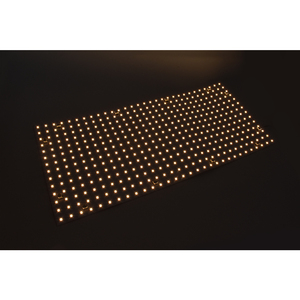(147171 products available)































































































































































































































LEDs for can lights are available in various types depending on the housing and trim design. The housings and trims of these lights are designed for different applications and to suit various preferences. Discussed below are the different types of LED lights for can lights
LED Downlights
LED downlights are the most common types of can lights. They are installed in recessed housings and direct light downwards. LED downlights for recessed lights offer a wide range of color temperatures and sizes. They are suitable for accent lighting and general ambient lighting.
Baffle Trims
Baffle trims come fitted with LED bulbs and are used to cover the opening of recessed lights. They have ridged interior surfaces that help reduce glare by minimizing the reflection of light. Baffle trims are ideal for situations where comfortable and diffused lighting is required.
Reflector Trims
LED reflector trims are also used in can lights. They are designed to enhance the brightness and focus light in a specific direction. Unlike baffle trims, these LED lights have a smooth or slightly curved reflective surface. This allows them to produce a more intense and concentrated beam of light. They are perfect for tasks that require focused lighting or for highlighting particular areas or objects.
Adjustable Trims
Adjustable trims are designed to be installed in recessed can lights that are intended to be directed or angled toward a specific object or area. They come with LEDs that are adjustable and can tilt or rotate to illuminate a desired target. These features make adjustable LED trims ideal for accent lighting and highlighting artwork or architectural elements.
Wall Wash Trims
Wall wash LED trims are designed to be installed in can lights specifically meant to illuminate walls. They are constructed to produce a broad and even light wash across wall surfaces. This feature helps to enhance the perception of space and can be used for wall lighting or accentuating architectural features.
New Construction LED Can Lights
New construction LED lights are fitted into homes that are being newly constructed. They are installed using mounting brackets that enable them to be attached securely to ceiling joists. These LED lights offer a clean and finished look, making them an ideal choice for new constructions.
Remodel LED Can Lights
Remodel LED can lights are ideal for homes that have already been constructed. They are designed to be installed in existing ceilings by using clips or retrofit rings that secure them within the recessed housing. These lights are easy to install and are used to upgrade or replace conventional incandescent lights.
When sourcing LED lights for recessed can lights, it's essential to understand the specifications and maintenance requirements to ensure that the lighting is sustainable and efficient. Here are the key specifications and maintenance considerations for LED can lights.
It's also important to maintain LED can lights for optimal performance. Here are the maintenance requirements:
Business buyers will need to consider several factors when sourcing LED recessed lighting for their business needs. These include;
Changing recessed lights to LED is a simple task that can be done with minimal tools and skills. When changing LED can lights, follow the steps below:
Q1: Can one use dimmable LED lights in non-dimmable fixtures?
A1: No, it is not advisable. Using dimmable LED lights in non-dimmable fixtures can cause flickering or reduce the lifespan of the bulb.
Q2: Are there any health risks associated with LED lights for can lights?
A2: There are no known health risks associated with LED lights for can lights. However, some studies have raised concerns about blue light and its potential effects on eye health.
Q3: How often should LED can lights be replaced?
A3: LED can lights have a longer lifespan compared to other types of lights. They can last up to 25,000 hours. Therefore, they should not be replaced frequently.
Q4: Can LED can lights be used outdoors?
A4: Yes. However, choosing LED can lights that are specifically designed for outdoor use and are rated for exposure to the elements is important.
Q5: Are LED can lights suitable for track lighting?
A5: LED can lights are designed for recessed lighting applications. However, LED downlights designed for track lighting are available if integrated into a track lighting system.
The keyword "led for can lights" shows a stable web search volume trend with an average of 8100 monthly web searches. Over the past year, the web search volume experienced a slight decline of 18%. The three-month change, however, remains unchanged at 0%.
Analyzing the monthly search data over the past year reveals some fluctuations. The web search volume peaked at 12,100 in February 2024 but generally settled back to an average of 8100 from March to November 2024. This pattern indicates a temporary spike in interest possibly influenced by seasonal trends or market promotions during that period.
The consistent return to the average web search volume following the February peak suggests that the interest in LED for can lights stabilizes after brief periods of heightened interest. The lack of further peaks or valleys in the subsequent months implies a steady demand without significant external influences affecting search behavior.